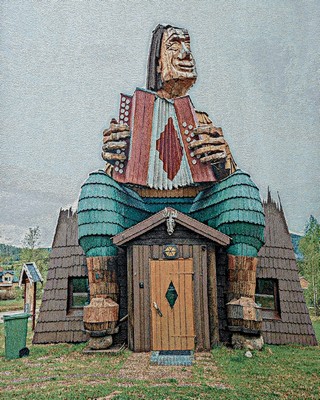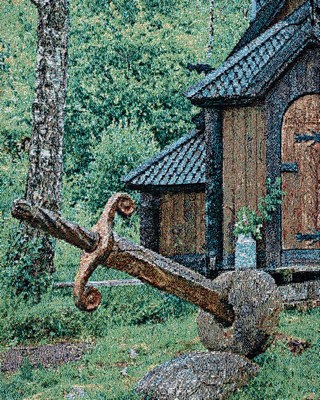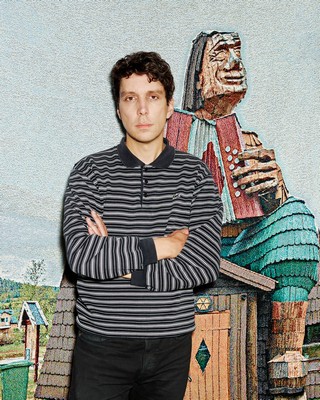Andreas Meinich: Gapahuk
Nevven Gallery, Gothenburg
November 23, 2023 — February 11, 2024
Finnskogajätten, 2023
Digitally woven cotton and polyester, wood pole,
edition 3/3 + 2 AP, 300 x 200 cm
© Andreas Meinich
Bastuknappen, 2023
Digitally woven cotton and polyester, wood pole,
edition 3/3 + 2 AP, 200 x 150 cm
© Andreas Meinich
Ortnevik II (detail), 2023
Digitally woven cotton and polyester, wood pole,
edition 3/3 + 2 AP, 200 x 150 cm
© Andreas Meinich
© Photo by Magnus Nordstrand
Text by Mattia LulliniKaihōgyō is an ancient ascetic practice used to be performed by Tendai Buddhist monks. Thought to have been initiated by Sōō Kashō in X Century Japan, the liturgy consisted in using hiking and running in the mountains as a form of meditation and path to illumination. Complexly structured, this observance took 1000 days to perform, in which the monks were supposed to cover by foot an average of 40 to 80 km per day.(1) In our fast paced yet mostly sedentary lives, endurance sports, and specially the ones involving long distances, like ultra running, through hiking or bikepacking have come back into fashion. While they are considered beneficial for physical health, an aspect mostly undervalued of these repetitive and slow paced, long lasting activities has been their capacity to become meditative and insightful experiences. There, like in the case of Japanese monks, is where the process behind Andreas Meinich’s art becomes relevant also if considered by itself and not only as a means to an end. The Norwegian photographer leaves every Summer for long bikepacking tours of Norway and sometimes Scandinavia at large. He follows some of the old traditional routes, but also ventures into less travelled regions, valleys and fjords, spending weeks at a time biking all day, sleeping in nature and taking photographs. It is in this routine of long miles and frugal living that his art originates.(2)The subjects of Meinich’s photography then are not exactly what one would expect from such an experience, or maybe even more so, they are too much of what one would expect. Filled with splendid views, towering folk sculptures and local minor attractions, the valleys of Norway teem with grotesque, clumsy or often unexpectedly monumental sights. They might be self-built stave churches (Ortnevik II, 2023), anthropomorphic rock formations (Ombomannen, 2023) or goofy sculptures found outside of saunas in the woods (Bastuknappen, 2023). They are exactly what each one of us, or any tourist, would snap a picture of as a memory, or, with more than just a pinch of irony, a funny Instagram story. The difference is that in Meinich’s photographs these images are presented to us neutrally and with no commentary, setting in motion a different kind of operation. The feeling is that by portraying these hidden and often remote sights, by bringing these idiosyncratic monuments out of their isolation and context, the Norwegian artist is presenting us with a unique depiction of his own country. Ridiculous, bizarre, serious, the subjects of his pictures are spontaneous folk expressions, they channel religious feelings, bigotry, profanity and tradition in equal parts, being honest to themselves and unfiltered. Could these photographs then be considered as a visual essay on Norwegian contemporary folklore? Meinich’s travels bring to mind the legendary accomplishment of Asbjørnsen and Moe and their famous collection of fairy tales Norske Folkeeventyr. Considered still a uniquely important record of traditional folk tales and songs, this collection of stories was the result of extensive travels by the two authors through the most remote parts of 1800s Norway, noting down ancient stories and rhymes transmitted orally only.(3) Seemingly, this is very similar to what Meinich is doing every Summer, only taking outdoor culture in place of oral culture, turning tales into photographs, then translating them again into digitally woven textiles. An operation, this last one, which is not neutral and also materially reminds of his most common subjects, both in monumentality and humour. With the aspect of antique tapestries, and the contrast coming natural to mind between the aristocratic past one would associate them with and the simplicity of their subjects, they themselves could have been considered folk art, tourist’s souvenirs, or an indoor continuation of the outdoor expressions they depict. These grand, beautiful objects that tell us about little things hidden in the vast woods of Norway, take physically the exhibition space with their tactility and their stories, which ironically or not, narrate a land in front of our eyes and yet hidden to most.Mattia Lullini(1) For more information: John Stevens, The Marathon Monks of Mount Hiei (1988).(2) From this activity derives the title of the exhibition: “The Norwegian word gapahuk means a simple shelter made out of wood. There are a lot of gapahuk in the rural part of Norway where I travel by bike and find the motifs for my weaves, and I often find myself using them for shelter on my trips.” (As described to us by the artist).(3) Peter Christian Asbjørnsen and Jørgen Moe, Norske Folkeeventyr (1844).
ANDREAS MEINICH was born in 1985, Stavanger, Norway. He lives and works in Oslo. The artist obtained a BA in Visual Communication at Oslo National Academy of the Arts (2008-2011).
NEVVEN GALLERY
Molinsgatan 11, 411 33 Göteborg




